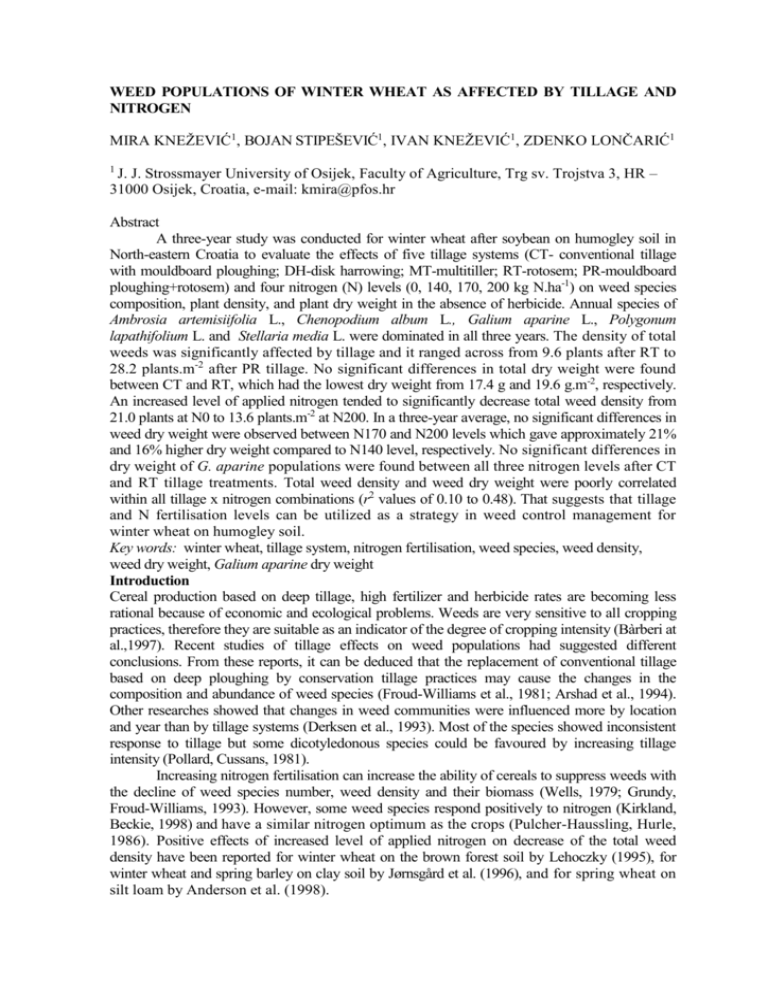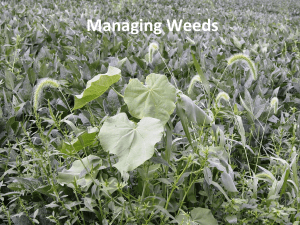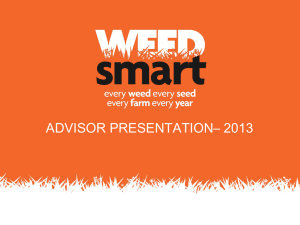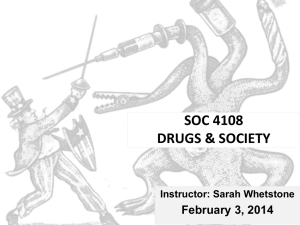264952.Weed_populations_of_winter_wheat
advertisement

WEED POPULATIONS OF WINTER WHEAT AS AFFECTED BY TILLAGE AND NITROGEN MIRA KNEŽEVIĆ1, BOJAN STIPEŠEVIĆ1, IVAN KNEŽEVIĆ1, ZDENKO LONČARIĆ1 J. J. Strossmayer University of Osijek, Faculty of Agriculture, Trg sv. Trojstva 3, HR – 31000 Osijek, Croatia, e-mail: kmira@pfos.hr 1 Abstract A three-year study was conducted for winter wheat after soybean on humogley soil in North-eastern Croatia to evaluate the effects of five tillage systems (CT- conventional tillage with mouldboard ploughing; DH-disk harrowing; MT-multitiller; RT-rotosem; PR-mouldboard ploughing+rotosem) and four nitrogen (N) levels (0, 140, 170, 200 kg N.ha-1) on weed species composition, plant density, and plant dry weight in the absence of herbicide. Annual species of Ambrosia artemisiifolia L., Chenopodium album L., Galium aparine L., Polygonum lapathifolium L. and Stellaria media L. were dominated in all three years. The density of total weeds was significantly affected by tillage and it ranged across from 9.6 plants after RT to 28.2 plants.m-2 after PR tillage. No significant differences in total dry weight were found between CT and RT, which had the lowest dry weight from 17.4 g and 19.6 g.m-2, respectively. An increased level of applied nitrogen tended to significantly decrease total weed density from 21.0 plants at N0 to 13.6 plants.m-2 at N200. In a three-year average, no significant differences in weed dry weight were observed between N170 and N200 levels which gave approximately 21% and 16% higher dry weight compared to N140 level, respectively. No significant differences in dry weight of G. aparine populations were found between all three nitrogen levels after CT and RT tillage treatments. Total weed density and weed dry weight were poorly correlated within all tillage x nitrogen combinations (r2 values of 0.10 to 0.48). That suggests that tillage and N fertilisation levels can be utilized as a strategy in weed control management for winter wheat on humogley soil. Key words: winter wheat, tillage system, nitrogen fertilisation, weed species, weed density, weed dry weight, Galium aparine dry weight Introduction Cereal production based on deep tillage, high fertilizer and herbicide rates are becoming less rational because of economic and ecological problems. Weeds are very sensitive to all cropping practices, therefore they are suitable as an indicator of the degree of cropping intensity (Bàrberi at al.,1997). Recent studies of tillage effects on weed populations had suggested different conclusions. From these reports, it can be deduced that the replacement of conventional tillage based on deep ploughing by conservation tillage practices may cause the changes in the composition and abundance of weed species (Froud-Williams et al., 1981; Arshad et al., 1994). Other researches showed that changes in weed communities were influenced more by location and year than by tillage systems (Derksen et al., 1993). Most of the species showed inconsistent response to tillage but some dicotyledonous species could be favoured by increasing tillage intensity (Pollard, Cussans, 1981). Increasing nitrogen fertilisation can increase the ability of cereals to suppress weeds with the decline of weed species number, weed density and their biomass (Wells, 1979; Grundy, Froud-Williams, 1993). However, some weed species respond positively to nitrogen (Kirkland, Beckie, 1998) and have a similar nitrogen optimum as the crops (Pulcher-Haussling, Hurle, 1986). Positive effects of increased level of applied nitrogen on decrease of the total weed density have been reported for winter wheat on the brown forest soil by Lehoczky (1995), for winter wheat and spring barley on clay soil by Jørnsgård et al. (1996), and for spring wheat on silt loam by Anderson et al. (1998). The aim of this study was to evaluate effects of different tillage and nitrogen levels on weed populations in winter wheat, on a humogley soil, without herbicide application in order to find ecologically safer strategies of weed control management for this crop. Material and methods Field trials were conducted in Eastern Croatia at Vrbanja locality from 1994 to 1996. The soil type was humogley with 2.3% of organic matter in the ploughing layer, nitrogen content was 48 kg.ha-1 as a mineral nitrate and pH determined in H2O was 7.2 (Stipešević, 1997). Soybean was the previous crop at the research plots which were tilled conventionally by mouldboard ploughing. Winter wheat (cv. Sana) was sown in the third decade of October in all years of the experiment without herbicide application. Monthly total precipitation and average air temperatures in the winter wheat growing seasons are presented in Table 1. A split-plot design layout included tillage as the main factor (T) and nitrogen level as the sub-factor (N), repeated in three seasons. The size of the sub-plot was 3 m by 19 m. Nitrogen treatments were replicated four times within each tillage treatment. The main factor included five tillage treatments: l. CT-conventional tillage (mouldboard ploughing to 20 cm depth, disk harrowing, standard sowing); 2. DH - disk harrowing (to 10 cm depth); 3. MT- tillage by multitiller with chisels; 4. RT- seedbed preparation (rototiller) + sowing by rotosem; 5. PRmouldboard ploughing to the 20 cm depth, seedbed preparation + sowing by rotosem. The subfactor included four nitrogen (N) levels: 0, 140, 170 and 200 kg N.ha-1. The nitrogen fertiliser was applied by broadcasting whereby 50% was applied before the sowing time and 50% was divided into two top dressings: at the tillering and the forking stages. P2O5 and K2O fertilisers were applied at all N treatments in the rates of 150 kg and 100 kg.ha-1, respectively. Each year weed plants were sampled at the forking stage (mid-April) and heading stage (the end of May and the beginning of June) of the crop. Weed samples were collected by counting plant numbers and recording the air dry (65oC) weight of each weed species in a 0.25 m2 circle replicated 16 times within each subplot, a total of 640 samples per year. Wheat ears were counted at the heading stage of crop in the same quadrants where weed plants were sampled. Weed species density was analysed by relative density which shows number of plants of each species expressed as a percentage of total weed number for each tillage and nitrogen variant. Life forms of species were determined according to Landolt (1977) and nomenclature of the species has been taken according to Ehrendorfer (1973). An analysis of variance was performed on total weed density and total weed dry weight for two assessed dates in all tillage and nitrogen treatments, as well as their combinations. The statistical package "Statistical Analysis System" (SAS V8.2 SAS Institute, Cary, NC) was used for all statistical analyses. The most frequent weed species of Galium aparine L. was also separately analysed at the heading stage of wheat only. The means were separated by PROC MIXED least square means separation with Fisher´s Protected LSD test at the 0.05 level of probability. Linear regression analyses were performed to evaluate univariate correlations between crop density and weed density, and between crop density and weed dry weight. Correlation analyses were performed for the total sample and for each tillage x nitrogen treatment combination separately. Results and discussion A total of forty-five weed species, forty-two dicotyledonous, two monocotyledonous (Bromus sterilis L. and Echinochloa crus-galli (L.) PB.) and one cryptogamous (Equisetum arvense L.) were recorded in winter wheat on the two sampling dates in the three-year study (Tables 2,3). Annual dicotyledonous weeds (T) dominated in all three years with 25 species compared with 11 annual/perennial (U) and 6 perennial species (H,G). The most abundant families of weed species were Asteraceae (8), followed Polygonaceae (5), Brassicaceae (4), Caryophyllaceae (3), Ranunculaceae (3), and Scrophulariaceae (3). The remaining 16 families had occurences of less than three weed species. 2 At the middle of April, when the wheat was mainly in the forking stage (tillering stage only in 1996), weed community was dominated by autumn emerging species such as Capsella bursa-pastoris (L.) Med., Lamium purpureum L., Papaver rhoeas L., Raphanus raphanistrum L., Thlaspi alliaceum L., Sinapis arvensis L., and Stellaria media (L.) Vill. At the same time a large number of Galium aparine L. and Polygonum lapathifolium L., more of one plant per m2 in all tillage treatments. A total dry weight of weed populations in the forking stage of wheat was generally low, ranging from 1.8 g.m-2 in 1996 to 5.32 g.m-2 in 1994 with significant differences (Table 4). No differences in weed dry weight in the first assessment were detected among tillage and nitrogen treatments, except in 1995 when a significant difference between CT and MT was observed. As weed community of wheat in the early spring was not yet floristically completed, their further analyses is focused on weed populations in the heading stage of wheat. Across the years, the highest density and dry weight of total weed populations were observed in 1994 (Table 4). Significant decreases in total weed density by 63% and 37% as well in total dry weight by 40% and 59% were found in 1995 and 1996, respectively, compared to the first year. The lowest value of total dry weight was observed in season of 1996, probably due to an unfavourable whether conditions. Namely, the autumn of 1995 (sowing on October 23) was unfavourable for a successful emergence of both weed species and crop plants that was attributed to the drought during October (Table 1) and early snow in the beginning of November. Due to the low temperature in March, the tillering stage of wheat and first node of stem elongation were prolonged until the end of April that was two to three weeks later than in the first two years. Five annual weed species which occurred with more than three plants per m2 during at least one year were: G. aparine, P. lapathifolium, Chenopodium album L., Ambrosia artemisiifolia L. and S. media. Most of them produced the highest number of plants and their dry weight in 1994 with the exception of G. aparine which the highest number of populations (4.1 plants.m-2) and dry weight (16.13 g.m-2) produced in 1995. Most other weed species displayed considerable year-toyear variation in germination, as well as in population densities. Effects of tillage In the three-year average, weed number of 28 plants.m-2 and weed dry weight of 46.5 g.m-2 were significant highest after PR tillage compared to all other tillage treatments (Table 4). Compared to CT conventional tillage, average increases of weed density and weed dry weight after PR tilled plots were 63% and 167%, respectively. A significant lowest weed density of 9.6 plants.m-2 was found after RT reduced tillage, which did not differ significantly compared to CT. For the combinations of year and tillage (Y x T) the analysis of variance shows significant differences in weed dry weight between CT and PR from each year as well between DH and MT tillage treatments in the first two years. Furthermore, the results showed that the response of individual species varied according to tillage treatment. Significant differences were difficult to detect due to a considerable variation in germination by years. Nevertheless, some responses could be identified (Table 2). For example, annual grass of B. Sterilis, as well as perennial species of Convolvulus arvensis L. and E. arvense were associated only with RT. Other perennial species such as Cirsium arvense (L.) Scop., Plantago major L. and Sonchus arvensis L. indicate also preference for RT, DH and MT reduced tillage treatments compared to both CT and PR ploughed treatments. These results concur with studies that documented an increasing of perennial weed densities in reduced or no tilled systems (Froud-Williams et al., 1981; Légère et al., 1990; Blackshaw et al., 1994). In our study, some winter or summer annual species such as P. rhoeas, Lactuca serriola L. and C. album were also associated with reduced tillage treatments over the duration of this experiment. With some exceptions, the most of other annual species (Fallopia convolvulus (L.) Löve, L. purpureum, P. lapathifolium, P. persicaria L., Sonchus oleraceus L.) showed a tendency 3 to increase densities with mouldboard plough tillage. Some of our findings concerning the annual species contradict some previous studies (Froud-Williams et al., 1981; Blackshaw et al., 1994; Bàrberi and Lo Cascio, 2001) which reported that populations of C. album usually responded to mouldboard ploughing whereas P. lapathifolium preferred a minimum tilled soil. Analysis of variance performed on dry weight of G. aparine, showed a preferential association with PR plough tillage in a three-year average. Compared to CT, dry weight increase of G. aparine populations was for 188% after the mentioned PR tillage (Table 4). This tillage effect was best expressed in 1995 and it was the lowest in 1996. Generally, the abundance of weed populations in our study probably reflected the effect of tillage on the seedbank size and seedling distribution in soil layer. This effect could also have been influenced by previous mouldboard ploughing, which was carried out on the same plots every two years for soybean crop. Namely, G. aparine and other weed seeds can persist in the soil and their increased germination in some season may be the result of older seeds being brought back to the surface. Bàrberi, Lo Cascio (2001) reported that weed seedbank size, as well as weed composition was influenced much more by tillage system than by the crop rotation. In all years, tillage influenced the crop density as expressed by ear number, which decreased significantly from 1994 to1996. Mean wheat densities were 577, 542 and 518 ears.m-2 in 1994, 1995 and 1996, respectively. The lower densities of wheat in 1996 may have been partially the result of the lower amounts of rainfall in that year. As shown in Table 1, precipitation during the third growing season of 1995-1996, October to July was 145 mm less than average of 647 mm in the first two growing seasons which probably influenced the crop density that was significantly lower than in the first two years. A poor crop density in 1996 affected crop yields which were for 780 kg.ha-1 or 16% less than average yield of 4915 kg.ha-1 obtained in the first two years. With respect to tillage, significantly highest crop density was detected in RT, whereas other tillage treatments were in between, with a roughly equal crop density. In a three-year average no statistically significant differences in wheat yields between CT and all other tillage treatments were found (Knežević et al., 1999). Effects of nitrogen Total number of weed species responded negatively to the increasing nitrogen level and declined from 43 on unfertilised control (N0) to 26 species at the highest N200 level (Table 3). Total weed density was the highest at N0. An increased level of applied nitrogen tended to decrease the total weed density from 21.0 plants at N0 to 13.6 plants.m-2 at N200, with significant differences (Table 4). No significant differences in weed density were observed between N140 and N170 levels. Similar to our findings, the highest weed densities at the lowest N rates have also been reported by Lehoczky (1995) for wheat on the brown forest soil and by Jørnsgärd et al. (1996) for wheat and barley on clay soil as well for spring wheat on silt loam by Anderson et al. (1998). Other studies have reported that N application had very low influence on the weed populations (Andersson, Milberg, 1998) or may have had no influence on species composition and weed density (Swanton et al., 1999). With respect to weed dry weight, no significant differences in a 3-year average were found between N170 and N200 levels, which give approximately 21% and 16% higher values of total dry weight compared to N140 level, respectively. A combination of year and nitrogen (Y x N) detected no significant differences in dry weight between all three applied nitrogen levels in the first season (Table 4). In the second season, it was significantly higher at N200 compared to all other nitrogen levels, whereas in the third season no significant differences in dry weight were observed between N140 and N170 levels which produced approximately 44% higher weed biomass compared to N200. A combination of tillage and nitrogen (T x N) has shown significant differences in total weed dry weight between two higher N170 and N200 levels only after DH 4 and PR tillage variants, which had the highest biomass production of 47.6 g and 74.1 g.m-2 at N170 and N200 levels, respectively. The populations of G. aparine have shown significant increase in their dry weight for 23% and 42% at N170 and N200 levels, respectively compared to N140 level. Both variants of N170 and N200 did not differ. A combination of tillage and nitrogen (T x N) detected the highest dry weight of G. aparine populations after PR tillage at N200 level, with an average increase for 168 % compared to both N170 and N140 levels with the same tillage treatment. The nitrogen effect was expressed also after the DH tillage but at N170 level where dry weight production was for 89% greater compared to the highest applied N200 rate. No significant differences in dry weight of G. aparine populations were found between all three nitrogen levels after CT and RT tillage treatments. The majority of other species in this study showed no response to any nitrogen levels (Table 3). The reason for that may have been in a relatively low weed infestation during the investigated seasons which caused that the differences in weed species responses to the nitrogen could not be detected. Differences among species composition under different tillage and N management were mostly affected by year, followed by tillage and N levels. For all combinations of tillage and nitrogen treatments, the correlations between weed density or weed dry weight and crop density were very weak. Namely, the highest r2 value for correlation between weed and crop density was only 0.48 (for combination of DH tillage and N0 nitrogen treatment). Most r2 values were lower than 0.10. The relatively poor weed infestation under all tilled treatments during the experiment, as well a low values of correlation coefficients suggested that weed population on investigated plots had a low competitiveness with winter wheat and was not the major factor in the crop yield production. In a three-year average, N fertilisation had a positive effect on wheat and significantly increased grain yield for 25, 35 and 45% at N140, N170 and N200 levels, respectively, compared to the unfertilised control (Knežević et al., 1999). This research suggests that depending on weed species composition and their population densities, tillage and N fertilisation levels can be utilized as a strategy in weed control management for a winter wheat on humogley soil. References Anderson, R.L., Tanaka, D.L., Black, A.L., Schweizer, E. E., 1998: Weed community and species response to crop rotation, tillage, and nitrogen fertility. Weed Technol., 12, p.531-536. Andersson, T.N., Milberg, P., 1998: Weed flora and the relative importance of site, crop, crop rotation, and nitrogen. Weed Sci., 46, p. 30 – 38. Arshad, M.A.,Gill, K.S., Coy, G,R., 1994: Wheat yield and weed population as influenced by three tillage systems on a clay soil in temperature continental climate. Soil Till. Res., 28, p. 227- 238. Bàrberi, P., Lo Cascio, B., 2001: Long-term tillage and crop rotation effects on weed seedbanksize and composition. Weed Res., 41, p. 325-340. Bàrberi, P., Silvestri, N., Bonari, E., 1997: Weed communities of winter wheat as influenced by input level and rotation. Weed Res., 37, p. 301-313. Blackshaw, R., Larney, F.O., Lindwall, C.W., Kozub, G. C., 1994: Crop rotation and tillage effects on weed populations on the semi-arid Canadian prairies. Weed Technol., 8, p. 231237. Derksen, D.A., Lafond, G.P., Gordon, A.T., Loeppky, H.A., Swanton, C.J., 1993: Impact of agronomic practices on weed communities: Tillage systems. Weed Sci., 41, p. 409-417. Ehrendorfer, F., 1973: Liste der Gefässpflanzen Mitteleuropas. Gustav Fisher Verlag Stuttgart, p. 1-318. Froud-Williams R.J., Chancellor, R.J., Drennan, D.S.H., 1981: Potential changes in weed floras associated with reduced-cultivation systems for cereal production in temperature regions. Weed Res., 21, p. 99-109. 5 Grundy, A.C., Froud-Williams, R.J., Boatman, N.D., 1993: The use of cultivar, crop seed rate and nitrogen level for the suppression of weeds in winter wheat. In: Proc. Brit. Crop Protec. Conf. Weeds, Brighton, UK, p. 997-1002. Jørnsgård, B., Rasmussen, K., Hill, J., Christiansen J.L., 1996: Influence of nitrogen on competition between cereals and their natural weed populations. Weed Res., 36, p. 461- 470. Kirkland, K.J., Beckie, H.J., 1998: Contribution of nitrogen fertilizer placement to weed management in spring wheat (Triticum aestivum). Weed Technol., 12, p. 507-514. Knežević, M., Đurkić, M., Antonić, O., Žugec, I.., 1999: Effects of soil tillage and nitrogen on winter wheat yield and weed biomass. Cereal Res. Commun., 27, p. 197-204. Landolt, E., 1977: Ökologische Zeigerwerte zur Schweizer Flora. Veröff. Geobot.Inst. ETH, Stiftung Rübel, 64, p. 1-207. Légère, A., Samson, N., Lemieux, C., Rioux, R., 1990: Effects of weed management and reduced tillage on weed populations and barley yields. In: Proc. EWRS Symp., Helsinki, Finland, p.111118. Lehoczky, E., 1995: Effect of nitrogen fertilization on crop-weed competition. In: Proc. EWRS Symp., Budapest, Hungary, p. 577–583. Pollard, F., Cussans, G.W., 1981: The influence of tillage on the weed flora in a succession of winter cereal crops on a sandy loam soil. Weed Res., 21, p.185-190. Pulcher-Haussling, M., Hurle, K., 1986: Einfluss der N-Düngung auf die Konkurrenz zwischen Unkrautern und Winterweizen. In: Proc. EWRS Symp., Stuttgart-Hohenheim, Germany, p.137 – 144. Stipešević, B., 1997: Utjecaj reducirane obrade tla na prinos ozime pšenice i otpor tla na hidromelioriranom glejnom tlu sjeveroistočne Hrvatske. MS Thesis, Agronomski fakultet Zagreb. Swanton, C.J., Shrestha, A., Roy, R.C., Ball-Coelho, B.R., Knezevic, S. Z., 1999: Effect of tillage systems, N, and cover crop on the composition of weed flora. Weed Sci., 47, p. 454 – 461. Wells, G.J., 1979: Annual weed competition in wheat crops: the effect of weed density and applied nitrogen. Weed Res., 19, p.185-191. 6






